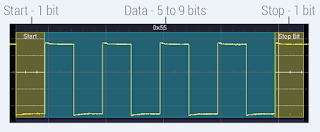 |
| Figure 1: A typical screen capture of UART serial decode/trigger software |
The Universal Asynchronous Receiver/Transmitter (UART) format supports a raft of different protocols. Perhaps the best-known of the lot is the venerable RS-232 protocol. The UART bus is an asynchronous type with rates that vary widely across different applications. It comprises a receive line, transmit line, and various handshaking communication lines that depend on the use case. The basic UART packet format consists of a start bit; 5 to 9 data bits; an optional parity bit; and either 1, 1.5, or 2 stop bits (Figure 2).
 |
| Figure 2: A representative UART packet's makeup |
A fully customizable trigger means that the oscilloscope can trigger on any UART-based signal, even if the bus protocol is proprietary, by selecting the appropriate bit rate, parity, bus polarity, bit order, and stop-bit settings. The software also should support both 8- and 9-bit formats.
With properly equipped serial trigger/decode software, you can trigger on specific data values on a UART-based bus. The trigger may be set up by entering a data pattern in either binary or hex formats. With binary triggering, you gain the flexibility of triggering on individual bits in a pattern, while hex triggering simplifies the setup of long data-pattern triggers. Patterns of up to 12 bytes are supported. Another feature of a powerful serial trigger/decode package is conditional trigger settings such as less than, greater than, in range, and out of range. These can really help you get a handle on abnormalities in a UART signal.
No comments:
Post a Comment